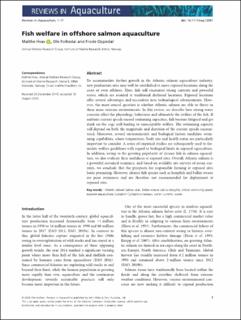| dc.description.abstract | To accommodate further growth in the Atlantic salmon aquaculture industry, new production sites may well be established at more exposed locations along the coast or even offshore. Here, fish will encounter strong currents and powerful waves, which are avoided at traditional sheltered locations. Exposed locations offer several advantages and necessitate new technological advancements. However, the most crucial question is whether Atlantic salmon are able to thrive in these more extreme environments. In this review, we describe how strong water currents affect the physiology, behaviour and ultimately the welfare of the fish. If ambient current speeds exceed swimming capacities, fish become fatigued and get stuck on the cage wall leading to unacceptable welfare. The swimming capacity will depend on both the magnitude and duration of the current speeds encountered. Moreover, several environmental and biological factors modulate swimming capabilities, where temperature, body size and health status are particularly important to consider. A series of empirical studies are subsequently used to formulate welfare guidelines with regard to biological limits in exposed aquaculture. In addition, owing to the growing popularity of cleaner fish in salmon aquaculture, we also evaluate their usefulness at exposed sites. Overall, Atlantic salmon is a powerful sustained swimmer, and based on available site surveys of ocean currents, we conclude that the prospects for responsible farming at exposed sites looks promising. However, cleaner fish species such as lumpfish and ballan wrasse are poor swimmers and are therefore not recommended for deployment at exposed sites. | en_US |
